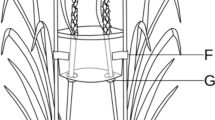Abstract
The olfactory receptor neurons in basiconic sensilla on the antennae ofUtetheisa ornatrix, which, in females, had earlier been shown to be responsive to stimulation with hydroxydanaidal (HD), are here shown to be responsive to volatile substances in samples of pyrrolizidine alkaloids (PAs). These latter substances are secondary plant metabolites present in the host plant of the larvae. Their sequestration during larval life serves to protect all life stages from predation. In males, the PAs also provide precursors for the production of the male pheromone, HD. In females, basiconic receptor neurons begin to respond to stimulus cartridges containing 1 ng of (R)-(−)-hydroxydanaidal, 100 ng of its isomer, (S)-(+)-hydroxydanaidal, and to volatiles emanating from 10μg of the alkaloids monocrotaline and heliotrine. Receptor neurons in males are generally responsive to the same array of substances but with reduced sensitivity. The dietary background of the adult moths with respect to prior ingestion of PAs does not influence the response capabilities of basiconic receptor neurons to HD or to the volatile components of PAs. Earlier studies in another arctiid (Rhodogastria), had indicated that trace amounts of HD are present in PAs, presumably as their hydrolysis product. Thus we assume that, under natural conditions, HD may be an active component of the volatiles from PAs and may serve as both a male pheromone and a kairomone. Sensitivity to HD could thereby provide information about the location and PA content of potential mates and food plants. Mechanisms that may have resulted in the evolution of a signaling system with these properties are discussed.
Similar content being viewed by others
References
Bogner, F. 1987. Spezialisierte Geruchsrezeptoren auf der Antenne und den Mundwerkzeugen von Lepidopteren, unter besonderer Berücksichtigung vonRhodogastria (Arctiidae). PhD thesis. Regensburg (1987).
Bogner, F., andBoppré, M. 1989. Single cell recordings reveal hydroxydanaidal as the volatile compound attracting insects to pyrrolizidine alkaloids.Entomol. Exp. Appl. 50: 171–184.
Boppré, M. 1986. Insects pharmacophagously utilizing defensive plant chemicals (pyrrolizidine alkaloids).Naturwissenschaften 73:17–26.
Boppré, M. 1990. Lepidoptera and pyrrolizidine alkaloids. Exemplification of complexity in chemical ecology.J. Chem. Ecol. 16:165–185.
Conner, W.E., Eisner, T., Van der Meer, R.K., Guerro, A., andMeinwald, J. 1981. Precopulatory sexual interaction in an arctiid moth (Utetheisa ornatrix): Role of a pheromone derived from dietary alkaloids.Behav. Ecol. Sociobiol. 9:227–235.
Conner, W.E., Roach, B., Benedict, E., Meinwald, J., andEisner, T. 1990. Courtship pheromone production and body size as correlates of larval diet in males of the arctiid moth,Utetheisa ornatrix.J. Chem. Ecol. 16:543–552.
Cuperus, P.L. 1985. Inventory of pores in antennal sensilla ofYponomeuta spp. (Lepidoptera: Yponomeutidae) andAdoxophyes orana F.v.R. (Lepidoptera: Torticidae).Int. J. Insect Morphol. Embryol. 14:347–359.
Dussourd, D.E., Ubik, K., Harvis, C., Resch, J., Meinwald, J., andEisner, T. 1988. Biparental defensive endowment of eggs with acquired plant alkaloid in the mothUtetheisa ornatrix.Proc. Natl. Acad. Sci. U.S.A. 85:5992–5996.
Eisner, T., andMeinwald, J. 1987. Alkaloid-derived pheromones and sexual selection in Lepidoptera. pp. 251–296,in G.D. Prestwich, and G.J. Blomquist (eds.. Pheromone Biochemistry, Academic Press, Orlando, Florida.
Grant, A.J., O'Connell, R.J., andHammond, A.M., Jr. 1988. A comparative study of pheromone perception in two species of noctuid moths.J. Insect Behav. 1:75–96.
Grant, A.J., O'Connell, R.J., andEisner, T. 1989. Pheromone-mediated sexual selection in the mothUtetheisa ornatrix: Olfactory receptor neurons responsive to a male-produced pheromone.J. Insect Behav. 2:371–385.
Johnson, A.E., Molyneux, R.J., andMerill, G.B. 1985. Chemistry of toxic range plants. Variations in pyrrolizidine alkaloid content ofSenecio, Amisichia, andCrotalaria.J. Agric. Food Chem. 33:50–55.
Kaissling, K.E. 1971. Insect Olfaction. pp. 351–431,in L. Beidler (ed.. Handbook of Sensory Physiology, IV, Chemical Senses, I, Springer-Verlag, Berlin.
Krasnoff, S.B., andDussourd, D.E. 1989. Dihydropyrrolizidine attractants for arctiid moths that visit plants containing pyrrolizidine alkaloids.J. Chem. Ecol. 15:47–60.
Mattocks, A.R. 1968. Chemistry and Toxicology of Pyrrolizidine Alkaloids. Academic Press, New York.
Miller, J.R., Baker, T.C., Cardé, R.T., andRoelofs, W.L. 1976. Reinvestigation of oak leaf roller sex pheromone components and the hypothesis that they vary with diet.Science 192:140–143.
O'Connell, R.J., Kocsis, W.A., andSchoenfeld, R.L. 1973. Minicomputer identification and timing of nerve impulses mixed in a single recording channel.Proc. IEEE 61:1615–1621.
Author information
Authors and Affiliations
Rights and permissions
About this article
Cite this article
Bogner, F., Grant, A.J. & O'Connell, R.J. A potential kairomone stimulates pheromone-responsive receptor neurons inUtetheisa ornatrix (Lepidoptera: Arctiidae). J Chem Ecol 18, 427–439 (1992). https://doi.org/10.1007/BF00994242
Received:
Accepted:
Issue Date:
DOI: https://doi.org/10.1007/BF00994242




